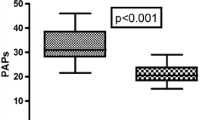Abstract
In this retrospective cohort study, we tried to evaluate the compliance of continuous positive airway treatment (CPAP) in the patients with or without previous surgical treatment to OSAS. Retrospective study with prospectively collected data was performed. Eighty-six consecutive OSAS patients who decided to try CPAP were enrolled, and data regarding polysomnography, history of previous surgical treatment and CPAP usage were collected. Among them, nine patients who had history of uvulopalatopharyngoplasty for OSAS were included in the surgery group and another 77 non-surgical patients were assigned to the untreated group. There was no statistical difference for demographics or polysomnographic parameters. They showed similar CPAP acceptance and air leak after the first trial. However, the surgery group (6.39 ± 1.49 h/day) used CPAP significantly longer than the untreated group (4.73 ± 1.64 h/day; p = 0.007) and less troubled with ‘waking up during night’. The present study showed that the prior surgery for OSAS doesn’t preclude the subsequent CPAP therapy.



Similar content being viewed by others
References
American Thoracic Society (1994) Indications and standards for use of nasal continuous positive airway pressure (CPAP) in sleep apnea syndromes. American Thoracic Society. Official statement adopted March 1944. Am J Respir Crit Care Med 150:1738–1745. doi:10.1164/ajrccm.150.6.7952642
Kushida CA, Littner MR, Hirshkowitz M, Morgenthaler TI, Alessi CA, Bailey D, Boehlecke B, Brown TM, Coleman J Jr, Friedman L, Kapen S, Kapur VK, Kramer M, Lee-Chiong T, Owens J, Pancer JP, Swick TJ, Wise MS (2006) Practice parameters for the use of continuous and bilevel positive airway pressure devices to treat adult patients with sleep-related breathing disorders. Sleep 29:375–380
Shapiro GK, Shapiro CM (2010) Factors that influence CPAP adherence: an overview. Sleep Breath 14:323–335. doi:10.1007/s11325-010-0391-y
So YK, Dhong HJ, Kim HY, Chung SK, Jang JY (2009) Initial adherence to autotitrating positive airway pressure therapy: influence of upper airway narrowing. Clin Exp Otorhinolaryngol 2:181–185. doi:10.3342/ceo.2009.2.4.181
Rolfe I, Olson LG, Saunders NA (1991) Long-term acceptance of continuous positive airway pressure in obstructive sleep apnea. Am Rev Respir Dis 144:1130–1133. doi:10.1164/ajrccm/144.5.1130
Sanders MH, Kern NB, Costantino JP, Stiller RA, Studnicki K, Coates J, Orris S, Schimerman S (1993) Adequacy of prescribing positive airway pressure therapy by mask for sleep apnea on the basis of a partial-night trial. Am Rev Respir Dis 147:1169–1174. doi:10.1164/ajrccm/147.5.1169
Pepin JL, Leger P, Veale D, Langevin B, Robert D, Levy P (1995) Side effects of nasal continuous positive airway pressure in sleep apnea syndrome. Study of 193 patients in two French sleep centers. Chest 107:375–381
Kim HY, Min JY, Cho DY, Chung SK, Dhong HJ (2007) Influence of upper airway narrowing on the effective continuous positive airway pressure level. Laryngoscope 117:82–85. doi:10.1097/01.mlg.0000244157.73951.f6
Li HY, Engleman H, Hsu CY, Izci B, Vennelle M, Cross M, Douglas NJ (2005) Acoustic reflection for nasal airway measurement in patients with obstructive sleep apnea-hypopnea syndrome. Sleep 28:1554–1559
Morris LG, Setlur J, Burschtin OE, Steward DL, Jacobs JB, Lee KC (2006) Acoustic rhinometry predicts tolerance of nasal continuous positive airway pressure: a pilot study. Am J Rhinol 20:133–137
Richards GN, Cistulli PA, Ungar RG, Berthon-Jones M, Sullivan CE (1996) Mouth leak with nasal continuous positive airway pressure increases nasal airway resistance. Am J Respir Crit Care Med 154:182–186. doi:10.1164/ajrccm.154.1.8680678
Friedman M, Tanyeri H, Lim JW, Landsberg R, Vaidyanathan K, Caldarelli D (2000) Effect of improved nasal breathing on obstructive sleep apnea. Otolaryngol Head Neck Surg 122:71–74
Mortimore IL, Bradley PA, Murray JA, Douglas NJ (1996) Uvulopalatopharyngoplasty may compromise nasal CPAP therapy in sleep apnea syndrome. Am J Respir Crit Care Med 154:1759–1762. doi:10.1164/ajrccm.154.6.8970367
Meslier N, Lebrun T, Grillier-Lanoir V, Rolland N, Henderick C, Sailly JC, Racineux JL (1998) A French survey of 3,225 patients treated with CPAP for obstructive sleep apnoea: benefits, tolerance, compliance and quality of life. Eur Respir J 12:185–192
Bollig SM (2010) Encouraging CPAP adherence: it is everyone’s job. Respir Care 55:1230–1239
Janson C, Noges E, Svedberg-Randt S, Lindberg E (2000) What characterizes patients who are unable to tolerate continuous positive airway pressure (CPAP) treatment? Respir Med 94:145–149
Masdon JL, Magnuson JS, Youngblood G (2004) The effects of upper airway surgery for obstructive sleep apnea on nasal continuous positive airway pressure settings. Laryngoscope 114:205–207. doi:10.1097/00005537-200402000-00005
Friedman M, Soans R, Joseph N, Kakodkar S, Friedman J (2009) The effect of multilevel upper airway surgery on continuous positive airway pressure therapy in obstructive sleep apnea/hypopnea syndrome. Laryngoscope 119:193–196. doi:10.1002/lary.20021
Chandrashekariah R, Shaman Z, Auckley D (2008) Impact of upper airway surgery on CPAP compliance in difficult-to-manage obstructive sleep apnea. Arch Otolaryngol Head Neck Surg 134:926–930. doi:10.1001/archotol.134.9.926
Han F, Song W, Li J, Zhang L, Dong X, He Q (2006) Influence of UPPP surgery on tolerance to subsequent continuous positive airway pressure in patients with OSAHS. Sleep Breath 10:37–42. doi:10.1007/s11325-005-0041-y
Smith I, Nadig V, Lasserson TJ (2009) Educational, supportive and behavioural interventions to improve usage of continuous positive airway pressure machines for adults with obstructive sleep apnoea. Cochrane Database Syst Rev :CD007736. doi:10.1002/14651858.cd007736
Conflict of interest
The authors have no conflicts of interest to disclose.
Author information
Authors and Affiliations
Corresponding author
Rights and permissions
About this article
Cite this article
Hong, S.D., Kim, H.Y., Cho, HJ. et al. Effect of uvulopalatopharyngoplasty on CPAP compliance. Eur Arch Otorhinolaryngol 272, 1437–1442 (2015). https://doi.org/10.1007/s00405-014-3239-4
Received:
Accepted:
Published:
Issue Date:
DOI: https://doi.org/10.1007/s00405-014-3239-4




